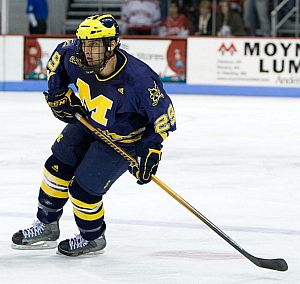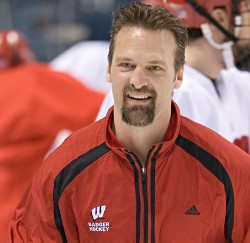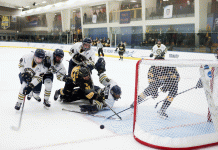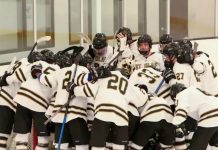“It’s one louder, isn’t it?” asks Nigel Tufnel in “This Is Spinal Tap.” “It’s not 10.”
Perhaps it’s just a personal perversion, but every time I think of the CCHA as an 11-team entity, I think of Nigel Tufnel’s magic amp, the one that is one louder.

Of course, the league’s not one louder. With the departure of Nebraska-Omaha, the CCHA is one less. It remains, however, one more than 10 — more than the Big Ten, that is.
Most importantly: The CCHA remains.
Before the season began, league commissioner Tom Anastos joked about the league having had no real offseason. “We had an unusually busy summer,” Anastos said. “As busy as last year was, hosting the Frozen Four and so on, coming off the year we had lots of changes going on … but it all has gone very, very well.”
The summer of 2009 included more than just preparation for the Frozen Four in Detroit, which was — by most measures — a success. The league was represented, thanks to the Miami RedHawks. Fans seemed to have enjoyed themselves. Detroit itself didn’t appear to have been maligned by the process.
The talk of the fate of the Alabama-Huntsville program and the enticement by the WCHA for one or more of the league’s teams depart were the other items on the 2009 summer agenda, along with the usual spate of rules changes.
At the time, we all thought that was quite a bit to digest over the course of a few short hockey-free months. The changing landscape that we’ve had to map out in more recent months, however, makes the summer of 2009 look like the good ol’ days.
It seems as though it has become customary to begin a discussion of any new CCHA season with a discussion of what’s just plain new.
One
Goodbye, Omaha. I say that with a good deal of sadness, and not just because the CCHA was the first league to take in the Mavericks (after others who will remain nameless rejected them), making the building of their program part of the league I’m lucky enough to cover.
In losing UNO, not only does the league lose a valued member in a large and important hockey market, but we’re losing a program that is absolutely going somewhere. With Dean Blais at the helm, the Mavericks are looking to begin construction on a new, more intimate — and wholly university owned — arena in 2011.
The loss of the Mavericks and the CCHA’s reluctance to add UAH to round out its membership leaves the league with an uneven number of teams, something that is more challenging to schedule. The league has split the league into two cluster-like entities, one that includes all three teams with sports otherwise affiliated with that uber-entity known as the Big Ten.
It’s not (Big) Ten … yet
To the surprise of some people who don’t take certain CCHA columnists seriously, Penn State announced that it’s adding men’s and women’s Division I ice hockey at the start of the 2012-13 season. This addition to the PSU and college hockey worlds come literally at the expense of Terry and Kim Pegula, whose $88 million donation is the largest private gift in the school’s history.
This development leaves everyone in the college hockey world — or at least those in the WCHA and CCHA, where other Big Ten affiliates play — wondering what will happen next.
The development also led to the CCHA wisely placing Michigan, Michigan State, and Ohio State in the same scheduling cluster-like entity for the immediate future. (Alaska and Ferris State fill out that five-team group.)
Both Wolverines coach Red Berenson and Spartans coach Rick Comley had something to say about this before the season began.
“I’m impressed that we’ve got a school like Penn State that made the commitment to Division I men’s and women’s hockey,” said Berenson, whose inflection emphasized the and between men’s and women’s, telling since Michigan does not have a D-I women’s team.
“I think that’ll bring other people into that level,” said Berenson, “where they might consider now going ahead with it. I think it’s good for college hockey overall.”
Said Comley, “Steve Cady, one of the architects of the college hockey game, put it out there: Has anybody thought about merging the two leagues and coming up with division that make sense?
“For us it would be the Big Ten division. I’m still hopeful that something like that can happen, where we play each other four times and I think that’s critical and will help our attendance very much here at Michigan State.
“I don’t know if we have to have a completely separate league, so I think there are an awful lot of things still to be determined.”
There are pros and cons about Michigan, Michigan State, Ohio State, Minnesota and Wisconsin joining Penn State in a Big Ten-only conference, but I like the way that Cady and Comley think.
It’s my nature to worry about such things now — like how the inevitability of Big Money will change the nature of the sport we love the most — but Berenson, naturally, has the right perspective. “Whether the Big Ten league takes shape as a full-blown league or a part-time league … we’ve got a couple of years to talk about it.”
The math in the meantime
In addition to the loss of UNO and the possibilities that new program in Happy Valley bring with it, there are other key changes in the league, namely three new coaches.

This year, the league sees Chris Bergeron move from Miami to take on the head coaching duties at Bowling Green; welcomes back Jeff Blashill to coach Western Michigan; and just welcomes Mark Osiecki at Ohio State. Each of these head coaches has the potential to bring great success to his specific program.
What else is there to talk about before the Big Ten may or may not bring doom to our beloved conference? Well, how about those RedHawks, whose second consecutive Frozen Four appearance marks the first time for a CCHA team since the Wolverines did so from 2001 to 2003.
Getting to the Frozen Four is no small matter, and getting there consecutively is extraordinary. Add to that the fact that two of the league’s three new head coaches coached under Miami’s Enrico Blasi, and you suddenly see a much fuller picture of an emerging program.
Miami’s success came at the expense of Michigan, unfortunately; the Wolverines’ uncharacteristically low finish at the end of the 2009-10 season only made their incredible CCHA championship and NCAA run more exciting.
Was Ferris State’s third-place finish a fluke? Was Notre Dame’s ninth-place finish likewise fluky? Will Northern Michigan and Alaska continue to build on their NCAA experience from a year ago? What will constitute the new middle ground and bottom tier in this new CCHA landscape? How will the scheduling affect the outcome? How will that hybrid icing work?
Here’s a look at each team in the order in which I’ve predicted the league to finish, and considering how I picked last year’s field — Notre Dame first, Michigan second, Michigan State eighth — this is hardly bankable. I do think that we have the ingredients for the most exciting CCHA season in recent memory and that we’ll all be surprised by more than a few of these 11 teams.
One thing I can predict with confidence: Each of these teams will play big this year, some bigger than the sum of their parts. We’re going to see a lot of great conference hockey this season.
Individual team previews can be accessed by clicking on each team’s name.
1. Miami
Head coach: Enrico Blasi, 12th season
2009-10 record: 29-8-7, 21-2-5-2 CCHA
2009-10 CCHA finish: First
2009-10 season ender: 7-1 loss to Boston College, national semifinal
2010-11 predicted ceiling/basement: First/third
Quotable: “We try to do things the right way, no different from any other program in our league,” Blasi said.
2. Michigan
Head coach: Red Berenson, 27th season
2009-10 record: 26-18-1, 14-13-1 CCHA
2009-10 CCHA finish: Seventh
2009-10 season ender: 3-2 double-OT loss to Miami, Midwest Regional final
2010-11 predicted ceiling/basement: First/fifth
Quotable: “I’ve always judged our teams by how good our seniors are,” Berenson said, “and with our seniors all staying, I think that means we should have good leadership and we should be a good team.”
3. Michigan State
Head coach: Rick Comley, ninth season
2009-10 record: 19-13-6, 14-8-6-2 CCHA
2009-10 CCHA finish: Second
2009-10 season ender: 5-3 loss to Michigan, CCHA quarterfinals
2010-11 predicted ceiling/basement: Second/fifth
Quotable: “We have opportunity,” Comley said. “As I watch our team, our talent, I think, is pretty good.”
4. Ferris State
Head coach: Bob Daniels, 19th season
2009-10 record: 21-13-6, 13-9-6-4 CCHA
2009-10 CCHA finish: Third
2009-10 season ender: 2-1 loss to Miami, CCHA third-place game
2010-11 predicted ceiling/basement: Third/sixth
Quotable: “If you look at it, that’s what pops out at you,” Daniels said, “the fact that we return the defense from last season.”
5. Alaska
Head coach: Dallas Ferguson, third season
2009-10 record: 18-12-9, 11-9-8-4 CCHA
2009-10 CCHA finish: Fifth
2009-10 season ender: 3-1 loss to Boston College, Northeast Regional semifinal
2010-11 predicted ceiling/basement: Third/sixth
Quotable: “I think one of the things we want to focus in on is just making sure we’re being consistent with everything that we’re doing in all facets of our program,” Ferguson said.
6. Northern Michigan
Head coach: Walt Kyle, ninth season
2009-10 record: 20-13-8, 13-9-6-3 CCHA
2009-10 CCHA finish: Fourth
2009-10 season ender: 4-2 double-OT loss to St. Cloud State, West Regional semifinal
2010-11 predicted ceiling/basement: Fourth/sixth
Quotable: “Getting a taste of [the NCAA tournament] will, I think, whet their appetite for more in the future,” Kyle said.
7. Ohio State
Head coach: Mark Osiecki, first season
2009-10 record: 15-18-6, 10-12-6-4 CCHA
2009-10 CCHA finish: Eighth
2009-10 season ender: 2-1 loss to Miami, CCHA quarterfinal
2010-11 predicted ceiling/basement: Fifth/11th
Quotable: “We’re not going to talk systems very often,” Osiecki said. “We want to talk about the people that we’re going to bring through the program and the culture that we’re going to create.”
8. Notre Dame
Head coach: Jeff Jackson, sixth season
2009-10 record: 13-17-8, 9-12-7-2 CCHA
2009-10 CCHA finish: Ninth
2009-10 season ender: 8-2 loss to Ohio State, CCHA first round
2010-11 predicted ceiling/basement: Fifth/11th
Quotable: “We’re going to get experience under fire, and that’s fine as long as we develop throughout the season and finish the season much stronger than we start,” Jackson said.
9. Western Michigan
Head coach: Jeff Blashill, first season
2009-10 record: 8-20-8, 4-17-7-2 CCHA
2009-10 CCHA finish: 12th
2009-10 season ender: 4-1 loss to Alaska, CCHA first round
2010-11 predicted ceiling/basement: Seventh/11th
Quotable: “We’re going to need to create a culture that guys want to choose greatness on a daily basis,” Blashill said, “that they understand it’s a daily choice that we’re going to make, and that it takes great work and great sacrifice to achieve that.”
10. Bowling Green
Head coach: Chris Bergeron, first season
2009-10 record: 5-25-6, 4-18-6-5 CCHA
2009-10 CCHA finish: 11th
2009-10 season ender: 6-1 loss to Nebraska-Omaha, CCHA first round
2010-11 predicted ceiling/basement: Seventh/11th
Quotable: “The culture we want to create is one where we just have very high expectations for ourselves and for each other and we hold each other accountable for those expectations,” Bergeron said.
11. Lake Superior
Head coach: Jim Roque, sixth season
2009-10 record: 15-18-5, 10-15-3-2 CCHA
2009-10 CCHA finish: 10th
2009-10 season ender: 6-0 loss to Michigan, CCHA first round
2010-11 predicted ceiling/basement: Seventh/11th
Quotable: “We have some older freshmen,” Roque said. “That’s who we recruit and they seem to have come in in very good shape.”


